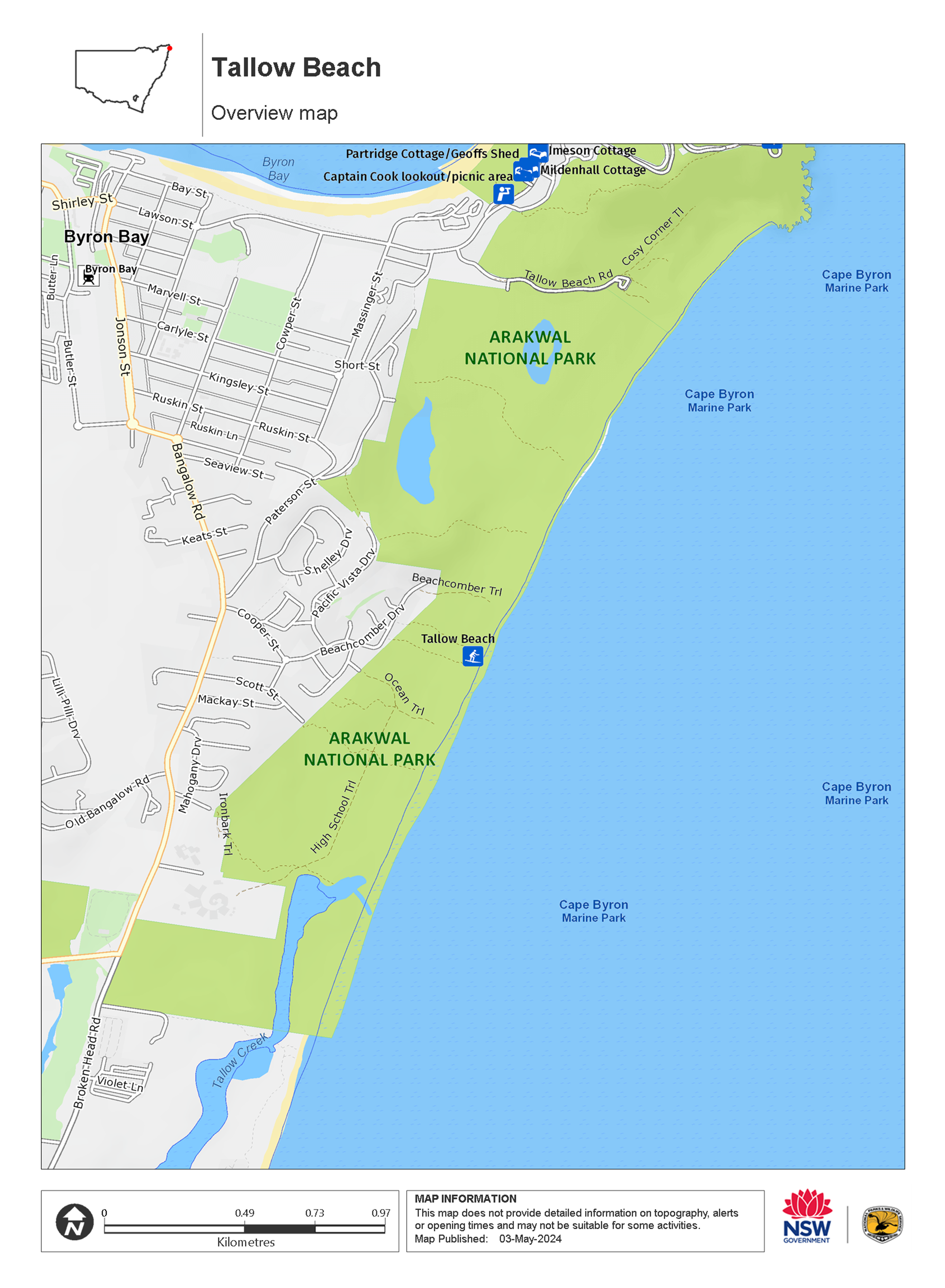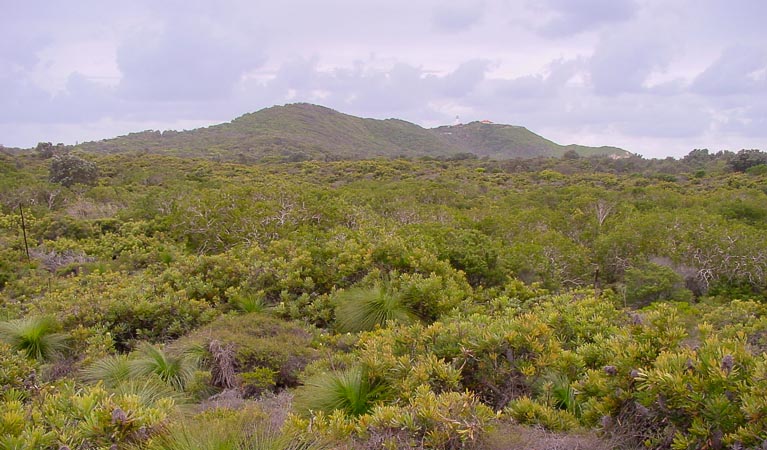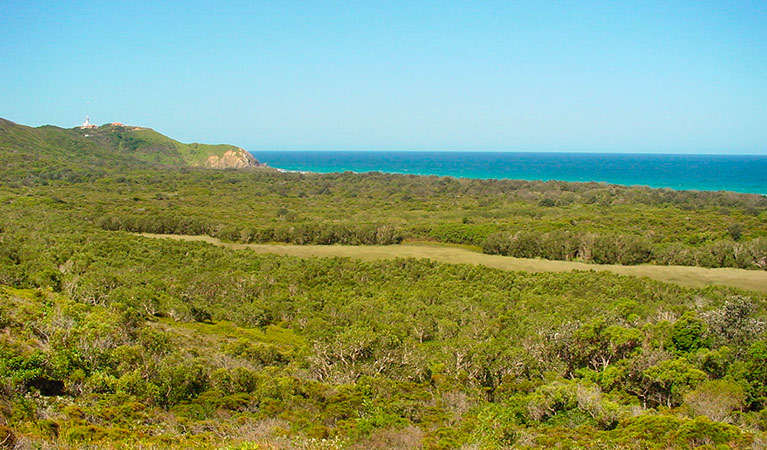Tallow Beach
Arakwal National Park
Overview
Tallow Beach is 3.2km from the heart of Byron Bay and a great place for swimming, birdwatching, whale watching, beach fishing, and just throwing down a towel to soak up the sun.
- Where
- Arakwal National Park in North Coast
- What to
bring - Drinking water, hat, sunscreen
- Please note
- Check the tide before you set out as this may affect your beach walking
- The weather in this area can be extreme and unpredictable, so please ensure you’re well-prepared for your visit.
A scenic bridge between Cape Byron State Conservation Area and Broken Head Nature Reserve, Tallow Beach offers a terrific place to throw down a towel and soak up the sun. You could pull out binoculars for an afternoon of whale watching in spring and winter though, as whales migrate between the Great Barrier Reef and Antarctica.
Just 3.2km from the heart of Byron Bay, Tallow Beach is alive with osprey and white-bellied sea eagles scouring the coast in search of food. As you relax on the sand, pied oystercatchers wander past searching for pippis. Avid birdwatchers will find more to see behind the dunes adjacent to residential areas, where many paper bark trees provide plenty of hiding holes for our feathered friends.
Beach fishing is possible here, as well as surfing in the right tide. For swimming and surfing, please be aware of rip tides and keep an eye on children – Tallow Beach is unpatrolled. It is, nevertheless, very popular in summer, the school holidays and Easter, so arrive early for the best spot.
Map

Map legend

Local alerts
For the latest updates on fires, closures and other alerts in this area, see https://www.nationalparks.nsw.gov.au/things-to-do/surfing-spots/tallow-beach-activity/local-alerts
General enquiries
- National Parks Contact Centre
- 7am to 7pm daily
- 1300 072 757 (13000 PARKS) for the cost of a local call within Australia excluding mobiles
- parks.info@environment.nsw.gov.au
Park info
- in Arakwal National Park in the North Coast region
Arakwal National Park is always open but may be closed at times due to storm weather or fire danger.
Visitor info
All the practical information you need to know about Tallow Beach.
Getting there and parking
Get driving directions
Tallow Beach is in the eastern precinct of Arakwal National Park. The beach is accessed from Cosy Corner picnic area in Cape Byron State Conservation Area. To get there:
- Take Lawson Street east for approximately 2km from Byron Bay town centre
- Where Lawson Street becomes Lighthouse Road, turn right onto Tallow Beach Road and follow to the end.
Road quality
- Sealed roads
Vehicle access
- 2WD vehicles
Weather restrictions
- All weather
Parking
Parking is available at Cosy Corner picnic area. $4 per hour (pay and display machine), or buy an NPWS annual pass.
Best times to visit
There are lots of great things waiting for you in Arakwal National Park. Here are some of the highlights.
Spring
Watch from the beach as humpback whales pass by on their way home from the Great Barrier Reef to Antarctica, many with calves.
Summer
Take a dip at Tallow Beach to cool off from the summer heat.
Winter
Now, the humpback whales are heading north, migrating to the Great Barrier Reef for the cooler months. Don't forget the binoculars.
Weather, temperature and rainfall
Summer temperature
Average
20.3°C and 27.2°C
Highest recorded
35.1°C
Winter temperature
Average
12°C and 19.8°C
Lowest recorded
3.3°C
Rainfall
Wettest month
March
Driest month
September
The area’s highest recorded rainfall in one day
350.4mm
Facilities
- Toilets and picnic facilities are located at Cosy Corner picnic area
- Drinking water is not available in this area, so it’s a good idea to bring your own.
Maps and downloads
Permitted
Fishing
A current NSW recreational fishing licence is required when fishing in all waters.
Prohibited
Pets
Pets and domestic animals (other than certified assistance animals) are not permitted. Find out which regional parks allow dog walking and see the pets in parks policy for more information.
Smoking
NSW national parks are no smoking areas.
Learn more
Tallow Beach is in Arakwal National Park. Here are just some of the reasons why this park is special:
Animals on the move

Arakwal may be small from the outside, but its borders hold some important habitat for threatened plant species like the creatively-named stinking crypotocarya, and dark greenhood. Keen nature enthusiasts will find much of interest; bring the magnifying glass, but be careful not to damage what you see. The reserve is also a temporary home to a range of nomadic and migratory animals, which means it's never quite the same in any given season. During autumn and winter, for example, the growing, flowering and fruiting season attracts birds, flying foxes and micro bats. Then there are the humpback whales, drifting past out to sea as they cycle annually between Queensland and the freezing waters of the Antarctic.
This is Aboriginal land

The reserve falls within the custodial boundaries of Bundjalung nation, with prime importance for the local Arakwal People who lend their name to the national park. The Bundjalung of Byron Bay (Arakwal) Peoples' connection to the reserve was recognised in 2001, with the signing of an Indigenous Land Use Agreement between the Bundjalung of Byron Bay (Arakwal) People and the NSW State Government.
Plants and animals protected in this park
Animals
-

White-bellied sea eagle (Haliaeetus leucogaster)
White-bellied sea eagles can be easily identified by their white tail and dark grey wings. These raptors are often spotted cruising the coastal breezes throughout Australia, and make for some scenic bird watching. Powerful Australian birds of prey, they are known to mate for life, and return each year to the same nest to breed.
-

Superb fairy wren (Malurus cyaneus)
The striking blue and black plumage of the adult male superb fairy wren makes for colourful bird watching across south-eastern Australia. The sociable superb fairy wrens, or blue wrens, are Australian birds living in groups consisting of a dominant male, mouse-brown female ‘jenny wrens’ and several tawny-brown juveniles.
-

Koala (Phascolarctos cinereus)
One of the most renowned Australian animals, the tree-dwelling marsupial koala can be found in gum tree forests and woodlands across eastern NSW, Victoria and Queensland, as well as in isolated regions in South Australia. With a vice-like grip, this perhaps most iconic but endangered Australian animal lives in tall eucalypts within a home range of several hectares.
-

Humpback whale (Megaptera novaeangliae)
The humpback whale has the longest migratory path of any mammal, travelling over 5000km from its summer feeding grounds in Antarctica to its breeding grounds in the subtropics. Its playful antics, such as body-rolling, breaching and pectoral slapping, are a spectacular sight for whale watchers in NSW national parks.
Environments in this park
Education resources (1)
General enquiries
- National Parks Contact Centre
- 7am to 7pm daily
- 1300 072 757 (13000 PARKS) for the cost of a local call within Australia excluding mobiles
- parks.info@environment.nsw.gov.au
Operated by
- Byron Bay office
- Monday to Friday, 8.30am to 4.30pm.
- 02 6639 8300
- npws.tweedbyron@environment.nsw.gov.au
- 22 Tallow Beach Road, Byron Bay 2481
Park info
- in Arakwal National Park in the North Coast region
Arakwal National Park is always open but may be closed at times due to storm weather or fire danger.
What's nearby:
Things to do (51)
- Aboriginal culture (2)
- Adventure sports (1)
- Birdwatching and wildlife encounters (13)
- Cafes and kiosks (4)
- Canoeing/paddling (2)
- Cycling (4)
- Fishing (4)
- Historic heritage (6)
- Horse riding (3)
- Other experiences (2)
- Picnics and barbecues (11)
- Road trips and car/bus tours (1)
- Sightseeing (16)
- Snorkelling and scuba (2)
- Surfing (10)
- Swimming (8)
- Visitor centres (1)
- Walking (20)
- Waterfalls (10)
- Wildflowers (seasonal) (1)

